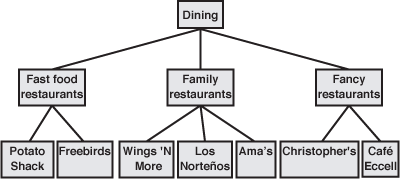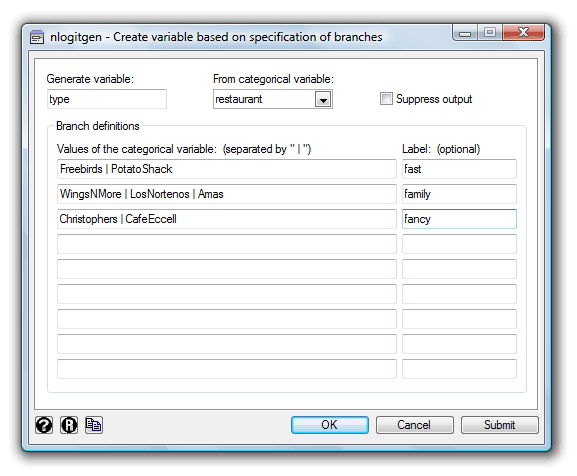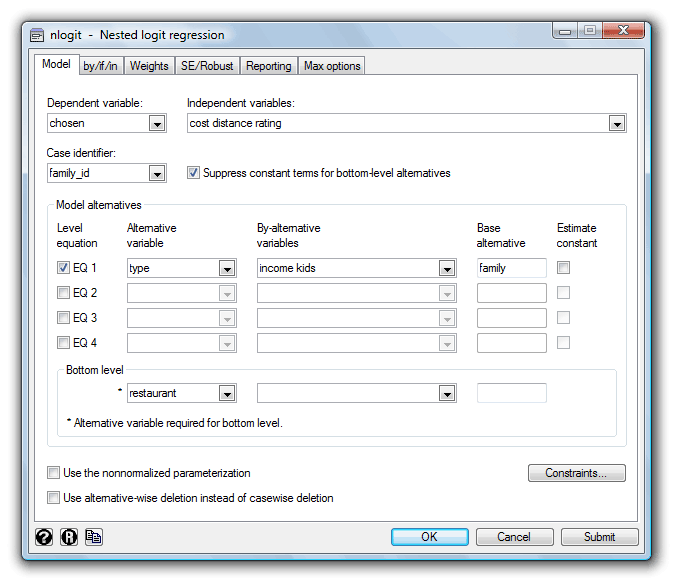Choice modeling
-
New command
asclogit
performs alternative-specific conditional logit regression, including
McFadden’s choice model. For models whose regressors vary by
alternative instead of by case, asclogit is more
convenient than
clogit.
-
New command
asroprobit
performs alternative-specific rank-ordered probit regression, allowing you
to model alternative-specific effects and the covariance structure of the
alternatives.
-
New command
exlogistic performs exact logistic regression. For more
information, click here.
-
Stata’s conditional logit command
clogit
now works with survey data.
-
Stata’s
nlogit
command for nested logit has been rewritten and has a new, better syntax
and runs faster; it now fits a model consistent with random utility
maximization by default. The new nlogit now
allows unbalanced groups and allows groups to have different sets of
alternatives. Let us show you:



. use http://www.stata-press.com/data/r10/restaurant, clear
. nlogitgen type = restaurant(fast:Freebirds | PotatoShack,
family: WingsNmore | LosNortenos | Amas,
fancy: Christophers | CafeEccell)
new variable type is generated with 3 groups
label list lb_type
lb_type:
1 fast
2 family
3 fancy
. nlogit chosen cost distance rating || type: income kids,
base(family) || restaurant:, noconst case(family_id)
tree structure specified for the nested logit model
type N restaurant N k
-------------------------------------
fast 600 --- Freebirds 300 12
+- PotatoShack 300 15
family 900 --- Amas 300 78
|- LosNortenos 300 75
+- WingsNmore 300 69
fancy 600 --- Christophers 300 27
+- CafeEccell 300 24
-------------------------------------
total 2100 300
k = number of times alternative is chosen
N = number of observations at each level
Iteration 0: log likelihood = -541.93581
Iteration 1: log likelihood = -517.95909 (backed up)
Iteration 2: log likelihood = -511.99261 (backed up)
(output omitted)
Iteration 16: log likelihood = -485.47333
Iteration 17: log likelihood = -485.47331
RUM-consistent nested logit regression Number of obs = 2100
Case variable: family_id Number of cases = 300
Alternative variable: restaurant Alts per case: min = 7
avg = 7.0
max = 7
Wald chi2(7) = 46.71
Log likelihood = -485.47331 Prob > chi2 = 0.0000
------------------------------------------------------------------------------
chosen | Coef. Std. Err. z P>|z| [95% Conf. Interval]
-------------+----------------------------------------------------------------
restaurant |
cost | -.1843847 .0933975 -1.97 0.048 -.3674404 -.0013289
distance | -.3797474 .1003828 -3.78 0.000 -.5764941 -.1830007
rating | .463694 .3264935 1.42 0.156 -.1762215 1.10361
------------------------------------------------------------------------------
type equations
------------------------------------------------------------------------------
fast |
income | -.0266038 .0117306 -2.27 0.023 -.0495952 -.0036123
kids | -.0872584 .1385026 -0.63 0.529 -.3587184 .1842016
-------------+----------------------------------------------------------------
family |
income | (base)
kids | (base)
-------------+----------------------------------------------------------------
fancy |
income | .0461827 .0090936 5.08 0.000 .0283595 .0640059
kids | -.3959413 .1220356 -3.24 0.001 -.6351267 -.1567559
------------------------------------------------------------------------------
dissimilarity parameters
------------------------------------------------------------------------------
type |
/fast_tau | 1.712878 1.48685 -1.201295 4.627051
/family_tau | 2.505113 .9646351 .614463 4.395763
/fancy_tau | 4.099844 2.810123 -1.407896 9.607583
------------------------------------------------------------------------------
LR test for IIA (tau = 1): chi2(3) = 6.87 Prob > chi2 = 0.0762
------------------------------------------------------------------------------
Here’s a complete list of what’s new in choice modeling:
-
New estimation command
asclogit performs alternative-specific
conditional logistic regression, which includes McFadden’s choice
model. Postestimation command
estat alternatives reports alternative-specific
summary statistics.
estat mfx reports marginal effects of regressors
on probabilities of each alternative. See [R]
asclogit and [R]
asclogit postestimation.
-
New estimation command asroprobit performs
alternative-specific rank-ordered probit regression.
asroprobit is related to rank-ordered logistic
regression
(rologit) but allows modeling
alternative-specific effects and modeling the covariance structure of the
alternatives. Postestimation command
estat alternatives provides summary statistics
about the alternatives in the estimation sample.
estat covariance displays the
variance–covariance matrix of the alternatives.
estat correlation displays the
correlation matrix of the alternatives.
estat mfx computes the marginal effects of
regressors on the probability of the alternatives. See [R]
asroprobit and [R]
asroprobit postestimation.
-
Stata now has exact logistic and exact Poisson regression. Rather than
having their inference based on asymptotic normality, exact estimators
enumerate the conditional distribution of the sufficient statistics and
then base inference upon that distribution. In small samples, exact
methods have better coverage than asymptotic methods, and exact methods
are the only way to obtain point estimates, tests, and confidence
intervals from covariates that perfectly predict the observed outcome.
Postestimation command estat se reports odds
ratios and their asymptotic standard errors.
estat predict, available only after
exlogistic
computes predicted probabilities, asymptotic standard errors, and exact
confidence intervals for single cases.
See [R]
exlogistic and [R]
expoisson.
-
Existing estimation command nlogit was rewritten
and has new, better syntax and runs faster when there are more than two
levels. Old syntax is available under version control.
nlogit now optionally fits the
random utilities maximization (RUM) model as well as the
nonnormalized model that was available previously. The new
nlogit now allows unbalanced groups and allows
groups to have different sets of alternatives.
nlogit now excludes entire choice sets (cases)
if any alternative (observation) has a missing value; use new option
altwise to exclude just the alternatives
(observations) with missing values. Finally,
vce(robust) is allowed regardless of the number
of nesting levels. See [R]
nlogit.
-
Existing estimation command asmprobit has the
following enhancements:
-
The new default parameterization estimates the covariance of the
alternatives differenced from the base alternative, making the
estimates invariant to the choice of base. New option
structural specifies that the previously
structural (nondifferenced) covariance parameterization be used.
-
asmprobit now permits estimation of the
constant-only model.
-
asmprobit now excludes entire choice sets
(cases) if any alternative (observation) has a missing value; use new
option altwise to exclude just the
alternatives (observations) with missing values.
-
New postestimation command estat mfx
computes marginal effects after asmprobit.
See [R]
asmprobit and [R]
asmprobit postestimation.
-
Existing estimation command clogit now accepts
pweights and may be used with the
svy: prefix.
Also, clogit used to be willing to produce
cluster-robust VCEs when the groups were not nested within the
clusters. Sometimes, this VCE was consistent, and other times it was not.
You must now specify the new nonest option to
obtain a cluster-robust VCE when the groups are not nested within
panels.
predict after clogit
now accepts options that calculate the Δβ influence statistic,
the Δchi2 lack-of-fit statistic, the Hosmer and
Lemeshow leverage, the Pearson residuals, and the standardized Pearson
residuals.
See [R]
clogit and [R]
clogit postestimation.
-
Existing estimation command
mprobit now allows
pweights, may now be used with the
svy: prefix, and has new option
probitparam that specifies that the probit
variance parameterization, which fixes the variance of the differenced
latent errors between the scale and the base alternatives to one, be used.
See [R]
mprobit.
-
Existing estimation command rologit now allows
vce(bootstrap) and
vce(jackknife). See [R]
rologit.
Back to highlights



